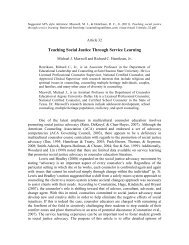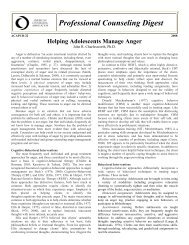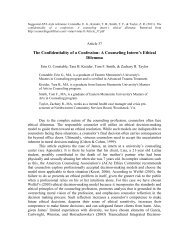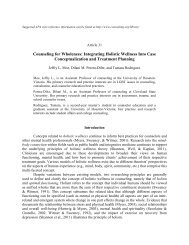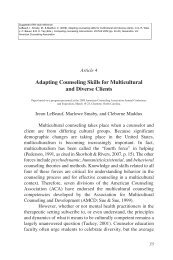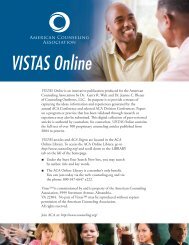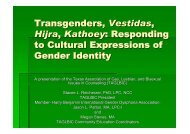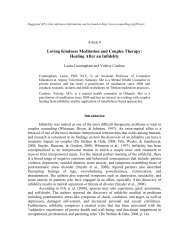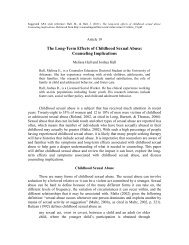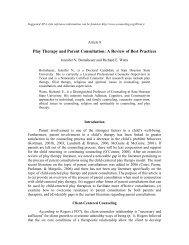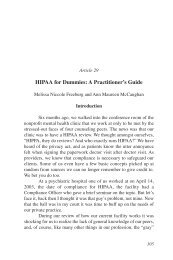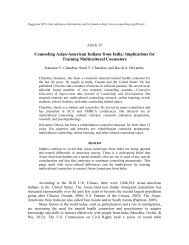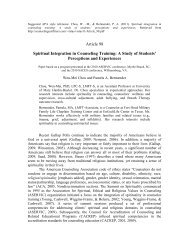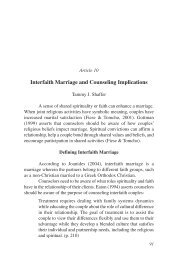The Needed Development of Multicultural Career Counseling Skills ...
The Needed Development of Multicultural Career Counseling Skills ...
The Needed Development of Multicultural Career Counseling Skills ...
Create successful ePaper yourself
Turn your PDF publications into a flip-book with our unique Google optimized e-Paper software.
Suggested APA style reference: Rush, L. C. (2010). <strong>The</strong> needed development <strong>of</strong> multicultural career counseling skills:If not now when? If not us who? Retrieved from http://counselingoutfitters.com/vistas/vistas10/Article_05.pdfArticle 5<strong>The</strong> <strong>Needed</strong> <strong>Development</strong> <strong>of</strong> <strong>Multicultural</strong> <strong>Career</strong> <strong>Counseling</strong> <strong>Skills</strong>: IfNot Now When? If Not Us Who?Lee Covington RushRush, Lee Covington, is an Assistant Pr<strong>of</strong>essor <strong>of</strong> <strong>Counseling</strong> at Northern IllinoisUniversity. He is a Counselor Educator with expertise in <strong>Career</strong> <strong>Counseling</strong> and<strong>Multicultural</strong> <strong>Counseling</strong>. Lee received his Ph.D. in Counselor Education andSupervision from <strong>The</strong> Ohio State University.It is clear that effective career counseling with people <strong>of</strong> color [and otherhistorically marginalized groups] does not occur in a cultural or contextualvacuum…<strong>The</strong> era <strong>of</strong> monocultural intervention has become history.<strong>Multicultural</strong>ly competent career counselors and vocational psychologistsshould continuously educate themselves with empirical research andliterature regarding career development <strong>of</strong> racially/ethnically [culturally]diverse clients and apply their knowledge and skills to clinical practice.(Flores, Lin, & Huang, 2005, pp.82-83)<strong>The</strong> above observation by Flores et al. (2005) speaks directly to and about theexigent need for career counselors and counseling pr<strong>of</strong>essionals to develop theirmulticultural career counseling competencies. <strong>The</strong>ir observation is especially meaningfulas the diversity <strong>of</strong> Americans continues to grow and the career related needs <strong>of</strong> many <strong>of</strong>its citizens are yet unmet. <strong>The</strong> current view <strong>of</strong> an individuals’ career development includethe entire life span, incorporating the varying life roles, cultural reference points andcontexts, racial/ethnic implications, environmental opportunities and barriers, genderconstraints, sexual orientation status, and disability status. Thus, it is the attendance toand awareness <strong>of</strong> these varying personal constructs by career pr<strong>of</strong>essionals andcounselors, which inform appropriate/successful multicultural career counselinginterventions. Pope (2000) reminds us <strong>of</strong> the development and evolution <strong>of</strong> careercounseling in America that framed the emergence <strong>of</strong> the multicultural movement whichthen provided the nexus for multicultural career counseling applications.Pope (2000) proposed that the history <strong>of</strong> career counseling and concomitantlyconcerns about career development occurred over six stages in America.1. Stage one between 1890-1919, with the development <strong>of</strong> placementservices for the burgeoning industrial / urban societies at the beginning <strong>of</strong>the twentieth century.
Ideas and Research You Can Use: VISTAS 20102. Stage two between1920-1939, and the emergence <strong>of</strong> guidanceprograms in elementary and secondary schools.3. Stage three between1940-1959, with the training <strong>of</strong> counselors at theuniversity level.4. Stage four between 1960-1979, when the pr<strong>of</strong>ession <strong>of</strong> counselingblossomed [and career theories were initially proposed], and concurrentlythe important idea <strong>of</strong> work having meaning in individuals lives came tothe fore.5. Stage five between 1980-1989, encompassing the movement from theindustrial eras to the information age in combination with the emergence<strong>of</strong> career counseling as a practice.6. Stage six 1990 through the present day, including technologicaladvances, exploding demographic changes, the growth <strong>of</strong> the multiculturalmovement, and the internationalization <strong>of</strong> career counseling practices. (p.194)As referenced by Pope (2000) and further articulated by Herr (2001), theevolution <strong>of</strong> career development constructs and career interventions emerged within andas a consequence <strong>of</strong> the social milieu <strong>of</strong> the times. Thus, career development wasoriginally built upon the work <strong>of</strong> Frank Parsons in the early 1900. Parsons’ model (1909)developed in the “climate <strong>of</strong> rapid urbanization, child labor issues, the rise <strong>of</strong>industrialization, the influx <strong>of</strong> immigrants, and the emergence <strong>of</strong> the human andbehavioral sciences” (Niles & Harris-Bowlsbey 2009, p. 15). This model or Parsonianapproach included three main steps: developing a thorough understanding <strong>of</strong> yourself;developing a knowledge <strong>of</strong> what is required for success [in an occupation]; applying truereasoning in terms the previous two steps (Niles et al., 2009). This construct is referredto as Trait and Factor <strong>The</strong>ory and represented one <strong>of</strong> the seminal points in what wouldbecome career development theory and career intervention processes. According toGysbers, Heppner, and Johnston (2003) the foundation <strong>of</strong> career theory and research thatwas developed in the early and mid 20 th Century incorporated a western Europeanworldview including: (a) individualism and autonomy, (b) affluence, (c) structure <strong>of</strong>opportunity open to all, (d) the centrality <strong>of</strong> work in people’s lives, and (e) the linearity,progressiveness, and rationality <strong>of</strong> the career development process (p. 53). If indeedcareer constructs were conceptualized on a western European model and exigency <strong>of</strong> thetimes, then their applicability with persons <strong>of</strong> color, women, and other marginalizedgroups is at best questionable.<strong>Multicultural</strong>ism and <strong>Counseling</strong><strong>The</strong> theory building vis-à-vis career development that occurred in the decades <strong>of</strong>the 1960s through the 1990s, provided career counselors and career pr<strong>of</strong>essionals withmodels upon which to conceptualize career behaviors, and design and implement careerinterventions. Corresponding to the growth and pr<strong>of</strong>essionalization <strong>of</strong> career counselingand counseling in general, there also emerged social unrest and calls for a more equitableand egalitarian attendance to the needs <strong>of</strong> an ever increasingly diverse Americancitizenry. This clarion call for social equity occurred across the breadth <strong>of</strong> the nation and2
Ideas and Research You Can Use: VISTAS 2010had implications for national policy, educational initiatives, institutions and their policies,overt and covert social norms, and all practices seen as inimical to non-majorityAmerican constituents. <strong>The</strong> need for changes in the way we do the business <strong>of</strong> Americaequally impacted varying pr<strong>of</strong>essional organizations across the country. Within thiscaldron <strong>of</strong> social flux and agitation, questions arose in terms <strong>of</strong> the efficacy <strong>of</strong> counselingparadigms for large groups <strong>of</strong> the American populace. Specifically questioned werecounseling and career counseling theories in terms their application with persons <strong>of</strong> color,women, gays and lesbians, and the disabled. In responding to these challenges themulticultural counseling movement was born.<strong>The</strong> raison d’etat <strong>of</strong> human services in general, and counseling and psychologyservices in particular, are the improvement, adjustment and/or the amelioration <strong>of</strong> humanproblems and difficulties over an individual’s life span. Thus, beyond historicalprecursors and theory building, it is the efficacy <strong>of</strong> interventions that hold thesuperordinate position. Sue, Arredondo, and McDavis (1992) in addressing the need formore culturally appropriate counseling models, proposed that multicultural competenciesare framed upon three broad areas: (a) the counselor’s awareness <strong>of</strong> his/her own culturalvalues and biases, (b) counselor’s awareness <strong>of</strong> the client’s culture and values, and (c) thecounselor’s use <strong>of</strong> culturally appropriate intervention strategies (p. 481). Each <strong>of</strong> thesebroad headings are further explicated in terms <strong>of</strong> the specific attitudes/beliefs, knowledgeand skills required within each category. <strong>The</strong> importance <strong>of</strong> multicultural counselingknowledge, awareness (including self-awareness), beliefs, attitudes, and skills are suchthat the American <strong>Counseling</strong> Association (ACA) specifically addresses variouscompetencies in its ACA Code <strong>of</strong> Ethics (2005). For example section A.2.c speaks to theimportance <strong>of</strong> counselors communicating information to clients in a manner that is“developmentally and culturally appropriate” (p. 4). Section E.5.b and section E.5.caddress the need to recognize the fact that culture impacts clients’ problem definition,that the socio-economic status <strong>of</strong> the client should be considered in terms <strong>of</strong> mentaldiagnosis, and that counselors remain cognizant <strong>of</strong> the historical implications <strong>of</strong> socialprejudice, and indeed misdiagnosis, on the culturally different client. In terms <strong>of</strong> theeducation and training for counselors, Section E.11.c <strong>of</strong> the ACA Code <strong>of</strong> Ethics (2005)states:Counselor educators actively infuse multicultural / diversity competencyin their training and supervision practices. <strong>The</strong>y actively train students togain awareness, knowledge, and skills in the competencies <strong>of</strong> multiculturalpractice. Counselor educators include…classroom activities thatpromote and represent various cultural perspectives. (p.16)Pedersen (1991) proposed a general theory <strong>of</strong> multicultural counseling framing abroad view <strong>of</strong> the construct. This view as articulated by Pedersen includesethnographics, demographics, status and affiliation, concluding that “the underlyingprinciples <strong>of</strong> multicultural theory would emphasize both the culture-specificcharacteristics that differentiate and the culture general characteristics that unite” (p. 7).Helms & Richardson (1997) see multicultural counseling and competency as the“capacity to read the various cultural dynamics <strong>of</strong> the clients (and therapist) and to reactto each <strong>of</strong> these aspects <strong>of</strong> cultures in a manner that best suites the client’s mental health3
Ideas and Research You Can Use: VISTAS 20103. <strong>Career</strong> Assessment <strong>of</strong> Ethnic Minority Women. C. Ward & R. Bingham (1993).Journal <strong>of</strong> <strong>Career</strong> Assessment, 1, 3.4. <strong>The</strong> <strong>Career</strong> <strong>Counseling</strong> Process with Racial-Ethnic Minorities: <strong>The</strong> Case <strong>of</strong> AsianAmericans. F. Leong (1993). <strong>The</strong> <strong>Career</strong> <strong>Development</strong> Quarterly 42, 1.5. Integrating a <strong>Multicultural</strong> Perspective into Training for <strong>Career</strong> <strong>Counseling</strong>:Programmatic and Individual Interventions. J. Swanson (1993). <strong>The</strong> <strong>Career</strong><strong>Development</strong> Quarterly, 42, 1.6. <strong>Career</strong> Assessment with Latinos/Hispanics. N. Fouad (1994). Journal <strong>of</strong> <strong>Career</strong>Assessment, 2.7. Racial Identity and <strong>Career</strong> Assessment. J. Helms (1994). Journal <strong>of</strong> <strong>Career</strong>Assessment 2, 3.8. <strong>Career</strong> Assessment with Asian-Americans. F. Leong & S. Leung (1994). Journal<strong>of</strong> <strong>Career</strong> Assessment 2, 3.9. Use <strong>of</strong> Interest Inventories with Special Populations: Women and MinorityGroups. N. Fouad & S. Spreda (1995). Journal <strong>of</strong> <strong>Career</strong> Assessment, 3, 4.10. <strong>Career</strong> Assessment with Lesbian, Gay, and Bisexual Individuals. J. Prince (1997).Journal <strong>of</strong> <strong>Career</strong> Assessment, 5, 2.11. Teaching <strong>Career</strong> <strong>Counseling</strong> <strong>Skills</strong> and Cultural Sensitivity. J. Krumboltz, M.Jackson, A. Ranier, & C. Yeh (1999). <strong>Career</strong> Planning and Adult <strong>Development</strong>Journal, 15.2000- To Present Day1. Preparing Counselors for <strong>Career</strong> <strong>Development</strong> in the New MillenniumACES/NCDA Position Paper. (2000). Author2. <strong>The</strong> <strong>Career</strong>-in-Culture Interview: A Semi-Structured Protocol for the Cross-Cultural Intake Interview. J. Ponterotto, L. Rivera, & L. Sueyoshi, (2000). <strong>The</strong><strong>Career</strong> <strong>Development</strong> Quarterly, 49.3. <strong>The</strong> Cultural Context <strong>of</strong> <strong>Career</strong> Assessment. D. Blustein & M. Ellis (2000).Journal <strong>of</strong> <strong>Career</strong> Assessment, 8, 4.4. <strong>Career</strong> Rehabilitation: Integration <strong>of</strong> Vocational Rehabilitation and <strong>Career</strong><strong>Development</strong> in the Twenty-First Century. M. Shahnasarian (2001). <strong>The</strong> <strong>Career</strong><strong>Development</strong> Quarterly, 495. <strong>Multicultural</strong> <strong>Career</strong> <strong>Counseling</strong>: Ten Essentials for Training. L. Flores & M.Heppner (2002). Journal <strong>of</strong> <strong>Career</strong> <strong>Development</strong>, 28, 3.6. <strong>Career</strong> <strong>Development</strong> <strong>of</strong> Women <strong>of</strong> Color and White Women: Assumptions,Conceptualization, and Interventions From an Ecological Perspective. E. Cook,M. Heppner, & K. O’Brien (2002). <strong>The</strong> <strong>Career</strong> <strong>Development</strong> Quarterly, 507. Teaching the <strong>Multicultural</strong> <strong>Counseling</strong> Competencies and Revised <strong>Career</strong><strong>Counseling</strong> Competencies Simultaneously. K. Evans & M. Larrabee (2002).Journal <strong>of</strong> <strong>Multicultural</strong> <strong>Counseling</strong> and <strong>Development</strong>, 30.8. Ethical and Processional Issues in <strong>Career</strong> Assessment with Diverse Racial andEthnic Groups. L. Flores, L. Spanierman, & E. Obasi (2003). Journal <strong>of</strong> <strong>Career</strong>Assessment, 115
Ideas and Research You Can Use: VISTAS 20109. Culturally Appropriate <strong>Career</strong> <strong>Counseling</strong> with Gay and Lesbian Clients. M.Pope, B. Barret, D. Szymanski, B. Chung, H. Singaravelu, R. McLean, & S.Sanabria (2004). <strong>The</strong> <strong>Career</strong> <strong>Development</strong> Quarterly 53.10. <strong>Multicultural</strong> <strong>Career</strong> <strong>Counseling</strong>: <strong>The</strong>oretical Applications <strong>of</strong> the Systems <strong>The</strong>oryFramework. M. Arthur & M. McMahon (2005). <strong>The</strong> <strong>Career</strong> <strong>Development</strong>Quarterly, 53.11. <strong>Multicultural</strong> and Gender Influences in Women’s <strong>Career</strong> <strong>Development</strong>: AnEcological Perspective. E. Cook, M. Heppner, & K. O’Brien (2005). Journal <strong>of</strong><strong>Multicultural</strong> <strong>Counseling</strong> and <strong>Development</strong>, 33.12. Racial/Ethnic Minority Vocational Research: A Content and Trend AnalysisAcross 36 Years. L. Flores, L. Berkel, J. Nilsson, L. Ojeda, S. Jordan, G. Lynn, &V. Leal (2006). <strong>The</strong> <strong>Career</strong> <strong>Development</strong> Quarterly, 5513. Metacognition and <strong>Multicultural</strong> Competence: Expanding the CulturallyAppropriate <strong>Career</strong> <strong>Counseling</strong> Model. A. Byars-Winston & N. Fouad (2006).<strong>The</strong> <strong>Career</strong> <strong>Development</strong> Quarterly, 54.14. Racial and Disability Identity: Implications for the <strong>Career</strong> <strong>Counseling</strong> <strong>of</strong> AfricanAmericans with Disabilities. E. Mp<strong>of</strong>u & D. Harley (2006). Rehabilitation<strong>Counseling</strong> Bulletin, 50.15. <strong>The</strong> Effects <strong>of</strong> Perceived Barriers, Role Models, and Acculturation on the <strong>Career</strong>Self-Efficacy and <strong>Career</strong> Consideration <strong>of</strong> Hispanic Women. L. Rivera, E. Chen,L. Flores, F. Blumberg, & J. Ponterotto. <strong>The</strong> <strong>Career</strong> <strong>Development</strong> Quarterly, 56.16. Gaining Cultural Competence in <strong>Career</strong> <strong>Counseling</strong>. K. Evans (2008). Boston:Lahaska Press.17. <strong>Career</strong> <strong>Development</strong> Concerns <strong>of</strong> Recent Immigrants and Refugees. O. Yakushko,A. Backhaus, M. Watson, K. Ngaruiya, & J. Gonzalez (2008). Journal <strong>of</strong> <strong>Career</strong><strong>Development</strong>, 34.18. <strong>The</strong> Resume’s Secret identity: A Tool for Narrative Exploration in <strong>Multicultural</strong><strong>Career</strong> <strong>Counseling</strong>. R. Toporek & C. Flamer (2009). Journal <strong>of</strong> Employment<strong>Counseling</strong>, 46.<strong>Multicultural</strong> <strong>Career</strong> <strong>Counseling</strong> EfficacyAs is evidenced by the previously outlined bibliographical summary, there hasbeen research and theory building specifically addressing the implementation <strong>of</strong>multicultural career counseling strategies. Evans (2008), in her book Gaining CulturalCompetence in <strong>Career</strong> <strong>Counseling</strong>, begins the discussion relating that it is the counselingskills and competences, in tandem with multicultural skills, awareness and knowledge,that builds the framework for the development <strong>of</strong> multicultural career counselingcompetencies. Of paramount import in gaining these skills, the counselor and /or careerpr<strong>of</strong>essional must begin with the understanding <strong>of</strong> and appreciation for his/her owncultural heritage. Within the context <strong>of</strong> this exploration <strong>of</strong> the self, the pr<strong>of</strong>essionalbegins to recognize the racialized society that is America and the Racial Identity<strong>Development</strong> (RID) status wherein he or she exists. Specifically, RID exploration andintrospection is, according to Helms (1984), “based on the premise that all people,regardless <strong>of</strong> race, go through a stage wise process <strong>of</strong> developing racial consciousnesswherein the final stage is an acceptance <strong>of</strong> race as a positive aspect <strong>of</strong> themselves and6
Ideas and Research You Can Use: VISTAS 2010others” (p. 154). For a full explanation <strong>of</strong> Racial Identity <strong>Development</strong> see Helms (1984).Other areas for examination according to Evans (2008) include examining one’s biases,recognizing unearned privilege, and beginning the process <strong>of</strong> understanding andinforming oneself about the worldview <strong>of</strong> the client. For the application <strong>of</strong> multiculturalcareer counseling skills, attitudes, and techniques, Evans proposed the following:1. Culturally adept career counselors are able to establish trusting relationships tohelp clients feel at ease during the counseling process.2. To maintain a culturally sensitive group, culturally competent counselors takecare to choose members <strong>of</strong> the group to maximize the benefits <strong>of</strong> groupcounseling and minimize conflicts. This is accomplished by facilitating culturalunderstanding among group members.3. <strong>Multicultural</strong>ly competent counselors should be aware that in some collectivistcultures client goals may be communal rather than personal.4. <strong>Multicultural</strong> career counselors should choose techniques that best fit their clients’problems and cultural backgrounds.5. <strong>Career</strong> counselors should understand that personality and personal characteristicsare influenced by race, ethnicity, gender, sexual orientation, and ability status, andthat these characteristics must be assessed accurately.6. <strong>Multicultural</strong>ly competent career counselors should be politically aware andunderstand that clients are impacted by societal and institutional policies.7. <strong>Multicultural</strong>ly competent career counselors should understand the expectationsthat families and cultural structures place on clients in their work environments8. <strong>The</strong> multiculturally competent career counselor should be aware that each client isdifferent, and that acculturation will dictate the need for family members and /orother important members <strong>of</strong> the community to become involved in the process.9. Identify and understand clients’ attitudes toward work and workers.10. Identify and understand clients’ biases toward work and workers based on gender,race, and cultural stereotypes.11. <strong>Multicultural</strong>ly competent career counselors understand how poverty,discrimination, racism, and so forth limit client access to information, inhibitclient ability to take action, and limit the scope <strong>of</strong> possibilities clients may see forthemselves.12. Culturally competent career counselors must be aware <strong>of</strong> discriminatory practicesat social and community agencies that may affect the psychological welfare <strong>of</strong> theclient.13. Support and challenge clients to examine life-work roles, including the balance <strong>of</strong>work, leisure, family, and community in their careers. <strong>Multicultural</strong>ly competentcareer counselors must realize that clients may need to be assisted in finding timefor leisure and community to balance their busy lives (pp. 145-146).Further extending the concept <strong>of</strong> multicultural career counseling requisites, Floresand Heppner (2002) articulated what they term as Ten Essentials for Training. <strong>The</strong>irdiscussion includes the changing demographics <strong>of</strong> America and the need formulticulturally competent career counselors to be aware <strong>of</strong> the people in theircommunities and cultural context within which they live. Similar to Evans (2008), these7
Ideas and Research You Can Use: VISTAS 2010researchers also propose that the culturally competent career counselor must understandhow the concept <strong>of</strong> career is defined by the culturally different client. In addressing thecareer counseling process, the development <strong>of</strong> a working alliance is deemed as the mostcritical component, and counselors are encouraged to maintain a stance <strong>of</strong> “creativeuncertainty” (p. 187). Other points <strong>of</strong> emphasis in terms <strong>of</strong> multiculturally skilled careercounseling competencies, include exploring the impact <strong>of</strong> racism, sexism and poverty onthe client’s self-efficacy and belief systems. Of additional note, Flores and Heppnerreported that “Evidence suggests that the assessment <strong>of</strong> culturally diverse individuals canbe problematic when the examiner is unfamiliar with the person’s cultural background”(p. 195). Thus it is imperative and ethically required that the “pr<strong>of</strong>essional understandsthe intricacies <strong>of</strong> the culture and can appropriately interpret the responses and behaviors<strong>of</strong> the individual” (p. 195).Ward and Bingham (1993) in investigating career assessment with ethnic minoritywomen proposed a <strong>Multicultural</strong> <strong>Career</strong> <strong>Counseling</strong> Checklist as an aid/guide for careerpr<strong>of</strong>essional to enhance their culturally appropriate initiatives and services. <strong>The</strong> checklistis divided into three areas: (a) counselor preparation, (b) exploration and assessment, and(c) negotiation and working consensus. <strong>The</strong> enumeration <strong>of</strong> some components <strong>of</strong> thischecklist can be instructive for career counselors and career pr<strong>of</strong>essionals. This author is<strong>of</strong> the opinion that while the checklist was based upon the concerns <strong>of</strong> women <strong>of</strong> color, ithas applicability for culturally sensitive career counseling with other marginalizedpopulations. Selected portions <strong>of</strong> the checklist include:1. Counselor preparationa. I am familiar with minimum cross-cultural competencies.b. I am aware <strong>of</strong> my client’s cultural identification.c. I am aware <strong>of</strong> my own world view and how it was shaped.d. I am aware <strong>of</strong> how my SES (socio-economic status) influences myability to empathize with this client.e. I have information about this client’s ethnic group’s history, localsociopolitical issues, and her/his attitudes towards seeking help.f. I am comfortable confronting ethnic minority clients.2. Exploration and assessmenta. I understand how the client’s career questions may be complicatedwith issues <strong>of</strong> finance, family, and academics.b. <strong>The</strong> client is presenting racial and or cultural information with thecareer questions.c. I know the client’s perception <strong>of</strong> her /his family’s ethnoculturalidentification.d. I am aware <strong>of</strong> the career limitations or obstacles the client associateswith her/his race or culture [gender, sexual orientation, disabilitystatus].e. I know the extent <strong>of</strong> exposure to career information and role modelsthe client had in high school and beyond.f. I am aware <strong>of</strong> the client’s perception <strong>of</strong> her /his competence, ability,and self-efficacy.8
Ideas and Research You Can Use: VISTAS 2010g. I know my stage <strong>of</strong> racial identity development.h. I know my client’s stage <strong>of</strong> racial identity development.3. Negotiation and working consensusa. I understand the type <strong>of</strong> career counseling help the client is seeking.b. <strong>The</strong> client and I have agreed on the goals for career counseling.c. I am aware <strong>of</strong> the extent <strong>of</strong> exposure to a variety <strong>of</strong> career role modelsthe client has had.d. I know the client understands the relationship between type <strong>of</strong> workand educational level.e. I am aware <strong>of</strong> the negative and/or self-defeating thoughts that areobstacles to the client’s aspirations and expectations.f. I am aware <strong>of</strong> the client’s expectations about the career counselingprocess.g. I am aware <strong>of</strong> the research support for using the selected instrumentwith clients <strong>of</strong> this ethnicity [gender, SES, sexual orientation,disability status]. (pp. 250-251)Evans (2008), Flores and Heppner (2002), Ward and Bingham (1993) and others,have provided starting points and guide posts from which to move forward in thedevelopment <strong>of</strong> multicultural career counseling efficacy. It is the tasks <strong>of</strong> all careerpr<strong>of</strong>essionals to fully engage with these and other applications so as to not only enhanceour competencies but, more urgently, to fully attend the needs <strong>of</strong> our clients. Inconceptualizing the new perspective in terms <strong>of</strong> culturally competent career counseling,Parmer and Rush (2003) provided a simple yet comprehensive definition “<strong>Career</strong>counseling is a discipline <strong>of</strong> trained pr<strong>of</strong>essionals dedicated to providing holistic,contextual, life-span counseling to a diverse clientele” (p. 31).Further ReflectionsThis discussion has been <strong>of</strong>fered to articulate and identify the need for theincorporation <strong>of</strong> multicultural competencies within career counseling constructs. In thiseffort, it appears that career scholars and vocational researchers have begun to outline andpropose varying skills, strategies, attitudes, and knowledge bases applicable in careerinterventions for the diversity that is now America. <strong>The</strong> exigent need for the inclusionand institutionalization <strong>of</strong> these competencies is <strong>of</strong> the moment. According to Winslow(2008), the recent U.S. Census Bureau indicates that the percentage <strong>of</strong> minorities inAmerica will increase from the current one-third <strong>of</strong> the nations population to the majorityby 2042 . <strong>The</strong> Asian community is expected to rise from 15.5 million to 40.6 million by2050 (Winslow, 2008). Hispanics will have the largest growth, followed by Blacks from41.1 million to 65.7 million. <strong>The</strong> White population will decrease from the current 66% to46%. Bingham & Ward ( as cited in Gysbers et al., 2003) specifically stated that “Ifvocational counseling was born from the changing demographics and economic needs <strong>of</strong>this century, then clearly career counseling will need to change in response to thechanging needs <strong>of</strong> the coming century” (p. 50). Of particular significance at this currentjuncture, in stressing the utmost importance <strong>of</strong> multicultural career counseling skills and9
Ideas and Research You Can Use: VISTAS 2010competencies, is the recently released Minimum Competencies for <strong>Multicultural</strong> <strong>Career</strong><strong>Counseling</strong> and <strong>Development</strong> (2009) released by the National <strong>Career</strong> <strong>Development</strong>Association. This document is <strong>of</strong> such precedence its introductory statement must beincluded in its entirety herein. Thus, stated:<strong>The</strong> purpose <strong>of</strong> the multicultural career counseling and developmentcompetencies is to ensure that all individuals practicing in, or training forpractice in the career counseling and development field are aware <strong>of</strong> theexpectation that we, as pr<strong>of</strong>essionals, will practice in ways that promotethe career development and functioning <strong>of</strong> individuals <strong>of</strong> all backgrounds.Promotion and advocacy <strong>of</strong> career development for individuals is ensuredregardless <strong>of</strong> age, culture, mental/physical ability, ethnicity, race,nationality, religion/spirituality, gender, gender identity, sexualorientation, marital/partnership status, military or civilian status, languagepreference, socioeconomic status, any other characteristics not specificallyrelevant to job performance, in accordance with NCDA and ACA policy.Further, they will provide guidance to those in the career counseling anddevelopment field regarding appropriate practice with regard to clients <strong>of</strong>a different background than their own. Finally, implementation <strong>of</strong> thesecompetencies for the field should provide the public with the assurancethat they can expect career counseling and development pr<strong>of</strong>essionals t<strong>of</strong>unction in a manner that facilitates their career development, regardless<strong>of</strong> the client’s/student’s background.NCDA Board, August 2009, p. 1ReferencesAmerican <strong>Counseling</strong> Association (2005). ACA code <strong>of</strong> ethics. Alexandria VA: Author.Evans, K. (2008). Gaining cultural competence in career counseling. Boston – NewYork: Lahask Press.Flores, L., & Heppner, M. (2002). <strong>Multicultural</strong> career counseling: Ten essentials fortraining. Journal <strong>of</strong> <strong>Career</strong> <strong>Development</strong>, 28, 181-201.Flores, L., Lin, Y., & Huang, Y. (2005). Applying the multicultural guidelines to careercounseling with people <strong>of</strong> color. In M. Constantine & D. Sue (Eds.). Strategies forbuilding multicultural competence in mental health and educational settings (pp.73-90). Hoboken, New Jersey: John Wiley & Sons, Inc.Gysbers, N., Heppner, M., & Johnston, J. (2003). <strong>Career</strong> counseling: Process, issues,and techniques (2nd ed. ). Boston: Allyn and Bacon.Hartung, P. (2002). Cultural context in career theory and practice: Role salience andvalues. <strong>The</strong> <strong>Career</strong> <strong>Development</strong> Quarterly, 51, 12-25.Helms, J. (1984). Towards a theoretical explanation <strong>of</strong> the effects <strong>of</strong> race on counseling ablack and white model. <strong>The</strong> <strong>Counseling</strong> Psychologist 12, 153-164.Helms, J. & Richardson, T. (1997). How multiculturalism obscures race and culture asdifferential aspects <strong>of</strong> counseling competency. In D. Pope-Davis & H. Coleman(Eds.). <strong>Multicultural</strong> counseling competencies: Assessment, education and10
Ideas and Research You Can Use: VISTAS 2010training and supervision (pp. 60-110). Thousand Oaks, California: SAGEPublications, Inc.Herr, E. (2001). <strong>Career</strong> development and its practice: A historical perspective. <strong>The</strong><strong>Career</strong> <strong>Development</strong> Quarterly, 49, 196-211.June, L. & Pringle, G. (1977). <strong>The</strong> concept <strong>of</strong> race in the career-development theories <strong>of</strong>Roe, Super, and Holland. Journal <strong>of</strong> Non-White Concerns, 6, 17-24.National <strong>Career</strong> <strong>Development</strong> Association. (2009). Minimum competencies formulticultural career counseling and development. Broken Arrow, OK: Author.Niles, S., & Harris-Bowlsbey, J. (2009). <strong>Career</strong> development interventions in the 21 stcentury (3 rd ed.). Upper Saddle River, NJ: Pearson Publishing.Osipow, S. & Fitzgerald, L. (1996).<strong>The</strong>ories <strong>of</strong> career development (4 th ed.). NeedhamHeights, Mass: Allyn & Bacon.Parmer, T., & Rush, L. (2003). <strong>The</strong> next decade in career counseling: Cocoonmaintenance or metamorphosis? <strong>The</strong> <strong>Career</strong> <strong>Development</strong> Quarterly, 52, 26-34.Pedersen, P. (1991). <strong>Multicultural</strong>ism as a generic approach to counseling. Journal <strong>of</strong><strong>Counseling</strong> & <strong>Development</strong>, 70, 6-12.Pope, M. (2000). A brief history <strong>of</strong> career counseling in the United States. <strong>The</strong> <strong>Career</strong><strong>Development</strong> Quarterly, 48, 194-211.Sue, D. W., Arredondo, P., & McDavis, R. (1992). <strong>Multicultural</strong> counselingcompetencies and standards: A call to the pr<strong>of</strong>essions. Journal <strong>of</strong> <strong>Counseling</strong> &<strong>Development</strong>, 70, 477-486.Ward, C. & Bingham, R. (1993). <strong>Career</strong> assessment <strong>of</strong> ethnic minority women. Journal<strong>of</strong> <strong>Career</strong> Assessment, 3, 246-257.Winslow, O. (2008). Census report sees minorities becoming majority by 2024.Newsday.com. Retrieved from http://www.newsday.com/news/local/logislend/nylicens0814,0,print.storyNote: This paper is part <strong>of</strong> the annual VISTAS project sponsored by the American <strong>Counseling</strong> Association.Find more information on the project at: http://counselingoutfitters.com/vistas/VISTAS_Home.htm11



